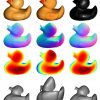Free Online Productivity Tools
i2Speak
i2Symbol
i2OCR
iTex2Img
iWeb2Print
iWeb2Shot
i2Type
iPdf2Split
iPdf2Merge
i2Bopomofo
i2Arabic
i2Style
i2Image
i2PDF
iLatex2Rtf
Sci2ools
CVPR
2009
IEEE
2009
IEEE
A Projective Framework for Radiometric Image Analysis
Different materials reflect light in different ways, and reflectance
interacts with shape, lighting, and viewpoint to
determine an object’s image. Common materials exhibit diverse
reflectance effects, and this is a significant source of
difficulty for radiometric image analysis. One strategy for
dealing with this diversity is to build computational tools
that exploit reflectance symmetries, such as reciprocity and
isotropy, that are exhibited by broad classes of materials. In
this paper, we advocate the real projective plane as a tool
for representing and exploiting these symmetries. In this approach,
each point in the plane represents a surface normal
that is visible from a fixed viewpoint, and reflectance symmetries
are analyzed in terms of the geometric structures
that they induce. We provide an overview of these structures
and explore applications to both calibrated and uncalibrated
photometric stereo.
| Added | 05 May 2009 |
| Updated | 10 Dec 2009 |
| Type | Conference |
| Year | 2009 |
| Where | CVPR |
| Authors | Ping Tan (National University of Singapore), Todd Zickler (Harvard University) |
Comments (0)

